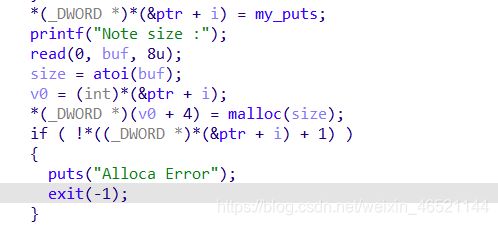- pwn速查手册(长期更新)
文章目录前言一、一般程序结构二、checksecRELROStackNXPIEFortifyDebuginfoStrippedSymbolsSHSTKIBT三、系统调用1、系统调用名与系统调用号查询2、系统调用参数查询3、系统调用参数顺序4、常用系统调用四、ShellCode快速生成前言有很多琐碎的东西,常用又难记,停用一段时间又容易忘,放在哪一篇文章里都不好查,所以专门开一篇用于记录和查阅。随学
- 快速刷通PWN的第三天
北辰孝卿
快速刷通PWN堆栈pythonpwn2ownc++linux
快速刷通PWN的第三天计划声明:因为是自己学习的一个计划,所以可能并不是适用于所有人。但是尽可能考虑到由浅入深,由易到难。昨天大概完成了Protostar的Stack4部分,今天继续后面题目的练习。笔记Stack5题目源码如下:#include#include#include#includeintmain(intargc,char**argv){charbuffer[64];gets(buffer
- Bugku CTF梳理
AquilaEAG
大佬的刷题记录:https://blog.csdn.net/mcmuyanga1.CTF常见题型CTF比赛通常包含的题目类型有七种,包括MISC、PPC、CRYPTO、PWN、REVERSE、WEB、STEGA。MISC(Miscellaneous)类型,即安全杂项,题目或涉及流量分析、电子取证、人肉搜索、数据分析等等。PPC(ProfessionallyProgramCoder)类型,即编程类题
- Bugku-CTF-Web安全最佳刷题路线
曾经的我也是CTF六项全能,Web安全,密码学,杂项,Pwn,逆向,安卓样样都会。明明感觉这样很酷,却为何还是沦为社畜。Bugku-CTF-Web安全最佳刷题路线,我已经整理好了,干就完了。尽管我们都是学了就忘,但是那又怎样,至少我们曾经会过:ailx10网络安全优秀回答者互联网行业安全攻防员去知乎咨询:ailx10难度系数1:刷题路线ailx10:Bugku-CTF-滑稽(查看源代码)ailx1
- [H&NCTF 2024] crypto/pwn
石氏是时试
python开发语言
周日的比赛,赛后拿别人的WP又作了俩,最后一个题也是没弄懂,先记一下吧。CryptoEZmath一个简单的函数题。在sagemath里有个two_squares函数,可以从平方和恢复两个规模相近的数。这种比较适合于RSA里的p,q。另外未知的e用来猜,一点意思都没有。fromCrypto.Util.numberimport*flag=b'Kicky_Mu{KFC_v_me_50!!!}'p=get
- DEFCON 29 Pwn 题目《3FACTOOORX》深度分析与利用详解
Alfadi联盟 萧瑶
网络安全网络安全
1.题目概览(ChallengeOverview)挑战名称3FACTOOORX所属比赛DEFCON29CTFQuals(2021)分类Web/BrowserExtension/JavaScriptSecurity目标简介与技术亮点3FACTOOORX是一个结合了Web安全、浏览器扩展安全和JavaScript混淆技术的高级挑战。题目要求参赛者分析一个Chrome浏览器扩展,逆向其中的混淆JavaS
- Ubuntu[22.04] PWN环境搭建
天才小周
ubuntu网络安全
Ubuntu[22.04]PWN环境搭建本章内容源自学长博客内容:学长博客更换镜像源cd/etc/apt#进入apt目录下sudocpsources.listsources.list.backup#备份sudovimsources.list#编辑sources.list文件#加入下面两个----之间的内容#默认注释了源码镜像以提高aptupdate速度,如有需要可自行取消注释debhttps://
- ret2libc:CTF Pwn 中的关键利用技巧
阿贾克斯的黎明
网络安全安全
目录ret2libc:CTFPwn中的关键利用技巧一、原理二、利用步骤(一)查找漏洞并确定溢出点(二)获取system()函数和字符串“/bin/sh”的地址(三)构造攻击载荷(payload)(四)触发漏洞并执行攻击三、示例代码(一)漏洞程序(vuln.c)(二)利用代码(exp.c)在CTF(夺旗赛)的Pwn题目中,ret2libc是一种极为重要且常用的漏洞利用技术。它主要针对程序中存在栈溢出
- Python爬虫实战教程:自动抓取CTF比赛题目存档全流程详解
Python爬虫项目
python爬虫开发语言github
1.CTF比赛简介及数据来源分析1.1什么是CTF比赛CTF(CaptureTheFlag)是信息安全领域的攻防竞赛,参赛队伍需解决一系列安全相关题目(称为“题目”),题目涉及逆向、漏洞利用、密码学、web安全等。1.2CTF题目存档的价值学习安全技术、积累攻防经验准备面试与实战技能提升搭建自己的CTF题库和知识库1.3典型CTF题目存档平台CTFTime—汇总比赛信息各大CTF比赛官网,如Pwn
- 2025一带一路暨金砖国家技能发展与技术创新大赛第三届企业信息系统安全赛项
Star abuse
安全全国职业院校技能大赛web安全CTF
企业信息系统安全赛项选拔赛包含CTF夺旗和企业网络安全配置与渗透两个项目,采用双人团队形式,比赛时长4小时。CTF夺旗阶段涵盖WEB渗透、密码学、流量分析、PWN和逆向5个任务模块,要求选手完成漏洞挖掘、密码破解、流量取证等实战操作。企业网络安全配置与渗透阶段需对模拟企业网络进行渗透测试与安全加固,包含10个具体任务,涉及站点渗透、数据库安全、WAF配置等内容。比赛采用即时评分机制,要求选手按指定
- 2024第八届全国职工职业技能大赛“网络与信息安全管理员”河北省预选拔赛解析
落寞的魚丶
2024第八届职工职业技能大赛网络安全网络与信息安全管理员省赛选拔赛CTF
2024第八届全国职工职业技能大赛“网络与信息安全管理员”某省选拔赛解析2024第八届全国职工职业技能大赛“网络与信息安全管理员”某省选拔赛解析第一场:CTFWeb:Web1:Web2:MISC:Crypto:crypto1:crypto2:PWN:PWN1:PWN2:第二场:数据安全:鹅鹅鹅:Antpro:需要培训可以私信博主欢迎交流学习!2024第八届全国职工职业技能大赛“网络与信息安全管理员
- CTF pwn -- ARM架构的pwn题详解
__lifanxin
网络安全ctfpwn网络安全pwnarm
arm架构的pwn题详解概述环境搭建使用QEMU使用gdb-multiarchARM架构基本知识arm32位寄存器介绍arm64位寄存器介绍一道例题参考博客总结概述 ARM架构过去称作进阶精简指令集机器(AdvancedRISCMachine,更早称作:AcornRISCMachine),是一个精简指令集(RISC)处理器架构,其广泛地使用在许多嵌入式系统设计。由于节能的特点,ARM处理器非常适
- 高中生手把手带你入门内核pwn -- QWB2018-core wp
A5rZ
网络安全
ctf-challenges/pwn/linux/kernel-mode/QWB2018-coreatmaster·ctf-wiki/ctf-challenges·GitHub参考:qwb2018核心复现ROP–wsxk’sblog–小菜鸡tips:如果你不理解某些部分,应该停下来而不是继续。core.cpio文件通常是一个归档文件,采用了CPIO格式。这种文件格式常用于存储多个文件和目录结构,尤
- 安恒安全培训实习生,CTF方向面试题!
go_to_hacker
面试CTF网络安全渗透测试测试工具web安全
目均模拟真实CTF赛题,需结合动态调试与工具链(pwntools/ROPgadget/one_gadget)完成利用。覆盖栈、堆、格式化字符串、高级堆利用、沙箱逃逸五大方向,从基础ROP到HouseofApple,逐步提升对抗防护的能力。题目1:栈溢出+ROP绕过NX与Canary名称:babyrop描述:目标程序是一个64位ELF文件,存在栈溢出漏洞,但开启了NX和Canary保护。请获取远程服
- 成为顶级黑客:从零开始学习网络渗透的完整指南,黑客高级教程建议收藏!
程序员七海
web安全黑客技术网络安全渗透测试计算机编程干货分享
前言网络安全再进一步细分,还可以划分为:网络渗透、逆向分析、漏洞攻击、内核安全、移动安全、破解PWN等众多子方向。今天的这篇,主要针对网络渗透方向,也就是大家所熟知的“黑客”的主要技术,其他方向仅供参考,学习路线并不完全一样。网络渗透网络渗透是攻击者常用的一种攻击手段,也是一种综合的高级攻击技术,同时网络渗透也是安全工作者所研究的一个课题,在他们口中通常被称为”渗透测试(PenetrationTe
- Apple Silicon配置二进制环境(二)
ZERO-A-ONE
macOS使用笔记linuxdocker运维
Author:ZERO-A-ONEDate:2022-07-31本系列旨在记录我本人在使用基于M1Pro的AppleSilicon芯片MacBookPro笔记本搭建适用于二进制研究的环境,包括逆向、PWN之类的场景0x1前序补充之前有朋友反映Wine配IDAPro还是有些麻烦,之后发现可以使用最新的PD虚拟机跑Windows11ARM,就可以直接跑IDAPro7.5或者IDAPro7.6提供一个我
- ⭐用docker + gdb + gdbserver优雅的调试pwn题⭐
INT_ZLSF
docker容器pwngdb
起源:利用patchelf+glibc-all-in-one来修改pwn题的libc和ld终究还是和真实的运行环境有所区别,尤其是在使用了libc-c++和异架构的情况下。再此之前我也尝试过其他师傅的调试方法,最有效的是在docker中使用有名管道pipe+tmux的组合,但是这个办法实测必须要先输入才能输出(pipe有阻塞的特性),还是不太好用。但是又不想再docker在安装一次pwn环境(pw
- Canary
Sean_summer
安全web安全
定义:Canary是一种用以防护栈溢出的保护机制。原理:是在一个函数的入口处,先从fs/gs寄存器中取出一个4字节(eax,四字节通常是32位的文件)或者8字节(rax,通常是64位的文件)的值存到栈上,当函数结束是会检查这个栈上的值是否和存进去的值相同。通常在pwn题写exp是用的字符a,这样存储进缓冲区,将会覆盖原始的canary的值当canary被覆盖后,也就是原应为canary的位置被字符
- ctfshow-stack36
dd-pwn
pwn
每天下午抖音(47253061271)直播pwn题,小白一只,欢迎各位师傅讨论可以发现全文只有一个ctfshow的自定义函数Gets函数,发现有溢出漏洞,可以利用该漏洞进行构建exp,发现有get_flag供我们使用,可以直接打开根目录的flag,因此只需要构造溢出,溢出返回地址覆盖成get_flag就行Exp:
- Pwn,我的栈溢出笔记就该这么写(上)
「已注销」
栈
一周的刨坟结束了,忙着搭建维护k8s,该整个小小的笔记了原理篇什么是栈溢出?栈溢出指的是程序向栈中某个变量中写入的字节数超过了这个变量本身所申请的字节数,因而导致与其相邻的栈中的变量的值被改变。栈溢出会导致什么结果?栈溢出漏洞轻则可以使程序崩溃,重则可以使攻击者控制程序执行流程。如何防范栈溢出?(1).金丝雀(canary)1、在所有函数调用发生时,向栈帧内压入一个额外的随机DWORD(数),这个
- ctfshow做题笔记—前置基础—pwn13~pwn19
Yilanchia
笔记学习
文章目录前言一、pwn13二、pwn14三、pwn15(编译汇编代码到可执行文件,即可拿到flag)四、pwn16(使用gcc将其编译为可执行文件)五、pwn17六、pwn18七、pwn19(关闭了输出流,一定是最安全的吗?)前言记录一下pwn13~pwn19,巩固一下学到的知识。一、pwn13知识点:如何使用GCCgccmain.c-oprogram·gcc是调用GCC编译器的命令。·-opro
- Django下防御Race Condition漏洞
落沐萧萧
djangopython后端
今天下午在v2ex上看到一个帖子,讲述自己因为忘记加分布式锁导致了公司的损失:我曾在《从Pwnhub诞生聊Django安全编码》一文中描述过关于商城逻辑所涉及的安全问题,其中就包含并发漏洞(RaceCondition)的防御,但当时说的比较简洁,也没有演示实际的攻击过程与危害。今天就以v2ex上这个帖子的场景来讲讲,常见的存在漏洞的Django代码,与我们如何正确防御竞争漏洞的方法。0x01Pla
- 【wp】hgame2023 week3 Re&&Pwn
woodwhale
ctf与君共勉pwnctfpwnrehgame
【wp】hgame2023week3Re&&PwnRecpp那个chacha20加密不会。kunmusic用dnspy逆dll,在Program的Main方法中找到了初始化的数据下断点执行,拷贝出data写一份脚本进行data与104的异或defstep_one():withopen("./data",encoding="u8")asf:lines=f.readlines()data=[]forl
- Pwntools 的详细介绍、安装指南、配置说明
程序员的世界你不懂
效率工具提升百度新浪微博
Pwntools:Python开源安全工具箱一、Pwntools简介Pwntools是一个由Securityresearcher开发的高效Python工具库,专为密码学研究、漏洞利用、协议分析和逆向工程设计。它集成了数百个底层工具的功能,提供统一的PythonAPI接口,广泛用于CTF竞赛、渗透测试和安全开发。其核心优势包括:模块化设计:支持密码学、网络协议、shellcode生成等全栈操作跨平台
- vulnhub(8):pWnOS(还没信息收集就已经成功打点)
anddddoooo
vulnhuboscp-like靶场linux运维网络安全安全服务器
端口nmap主机发现nmap-sn192.168.89.0/24Nmapscanreportfor192.168.89.116Hostisup(0.00020slatency).116是新出现的机器,他就是靶机nmap端口扫描nmap-Pn192.168.89.116-p---min-rate10000-oAnmap/scan扫描开放端口保存到nmap/scan下PORT STATESER
- ffmpeg合成视频
一个高效工作的家伙
大模型ffmpeg
记录下ffmpeg如何安装配置,以及如何合成视频。一、安装ffmpeg1、下载ffmpeg安装包打开DpwnloadFFmpeg官网,选择安装包Windowsbuildsfromgyan.dev2、下滑找到releasebulids部分,选择ffmpeg-7.0.2-essentials_build.zip3、下载完成后,解压缩得到FFmpeg文件夹。解压文件并检查目录结构解压后的文件夹中应包含以
- python软件安装教程-Python-中文版软件安装包以及安装教程
weixin_37988176
Python-3.5.2(32/64位)软件下载地址链接:https://pan.baidu.com/s/1O1GIOCudBqPWNP6voPMpEA密码:zp58安装步骤:1.鼠标右击软件压缩包,选择“解压到python-3.5.2”2.打开“python-3.5.2”文件夹,鼠标右击“python-3.5.2-amd64.exe”(32位电脑操作系统鼠标右击“python-3.5.2.exe
- PWN基础15:GOT表 和 PLT表
prettyX
PWN
在学习总结GOT、PLT表的相关知识,下面是我参考的文章和视频,每条资源都互有补充感谢各位作者的分享精神https://zhuanlan.zhihu.com/p/130271689https://blog.csdn.net/qq_18661257/article/details/54694748https://blog.csdn.net/linuxheik/article/details/8850
- pwn7(利用格式化字符串泄露libc)
再劝
网络安全算法linux服务器数据库
题目[HNCTF2022WEEK4]ezcanaryint__fastcallmain(intargc,constchar**argv,constchar**envp){chars[96];//[rsp+0h][rbp-170h]BYREFcharbuf[264];//[rsp+60h][rbp-110h]BYREFunsigned__int64v6;//[rsp+168h][rbp-8h]v6=
- hackcon ctf 2018 | pwn wp
fantasy_learner
BOF漏洞点:栈溢出利用过程栈溢出跳转callMeMaybe函数获得flagexpSheSellsSeaShells90流程分析:给出了输入的栈地址有一个栈溢出点没有nx利用过程:根据以上三点,得出可以使用ret2shellcode使用shellcraft生成shellcode利用栈溢出,输入并跳转到shellcodeexpSimpleYetElegent150这道题目做了最久,卡在了能否根据_d
- 解读Servlet原理篇二---GenericServlet与HttpServlet
周凡杨
javaHttpServlet源理GenericService源码
在上一篇《解读Servlet原理篇一》中提到,要实现javax.servlet.Servlet接口(即写自己的Servlet应用),你可以写一个继承自javax.servlet.GenericServletr的generic Servlet ,也可以写一个继承自java.servlet.http.HttpServlet的HTTP Servlet(这就是为什么我们自定义的Servlet通常是exte
- MySQL性能优化
bijian1013
数据库mysql
性能优化是通过某些有效的方法来提高MySQL的运行速度,减少占用的磁盘空间。性能优化包含很多方面,例如优化查询速度,优化更新速度和优化MySQL服务器等。本文介绍方法的主要有:
a.优化查询
b.优化数据库结构
- ThreadPool定时重试
dai_lm
javaThreadPoolthreadtimertimertask
项目需要当某事件触发时,执行http请求任务,失败时需要有重试机制,并根据失败次数的增加,重试间隔也相应增加,任务可能并发。
由于是耗时任务,首先考虑的就是用线程来实现,并且为了节约资源,因而选择线程池。
为了解决不定间隔的重试,选择Timer和TimerTask来完成
package threadpool;
public class ThreadPoolTest {
- Oracle 查看数据库的连接情况
周凡杨
sqloracle 连接
首先要说的是,不同版本数据库提供的系统表会有不同,你可以根据数据字典查看该版本数据库所提供的表。
select * from dict where table_name like '%SESSION%';
就可以查出一些表,然后根据这些表就可以获得会话信息
select sid,serial#,status,username,schemaname,osuser,terminal,ma
- 类的继承
朱辉辉33
java
类的继承可以提高代码的重用行,减少冗余代码;还能提高代码的扩展性。Java继承的关键字是extends
格式:public class 类名(子类)extends 类名(父类){ }
子类可以继承到父类所有的属性和普通方法,但不能继承构造方法。且子类可以直接使用父类的public和
protected属性,但要使用private属性仍需通过调用。
子类的方法可以重写,但必须和父类的返回值类
- android 悬浮窗特效
肆无忌惮_
android
最近在开发项目的时候需要做一个悬浮层的动画,类似于支付宝掉钱动画。但是区别在于,需求是浮出一个窗口,之后边缩放边位移至屏幕右下角标签处。效果图如下:
一开始考虑用自定义View来做。后来发现开线程让其移动很卡,ListView+动画也没法精确定位到目标点。
后来想利用Dialog的dismiss动画来完成。
自定义一个Dialog后,在styl
- hadoop伪分布式搭建
林鹤霄
hadoop
要修改4个文件 1: vim hadoop-env.sh 第九行 2: vim core-site.xml <configuration> &n
- gdb调试命令
aigo
gdb
原文:http://blog.csdn.net/hanchaoman/article/details/5517362
一、GDB常用命令简介
r run 运行.程序还没有运行前使用 c cuntinue
- Socket编程的HelloWorld实例
alleni123
socket
public class Client
{
public static void main(String[] args)
{
Client c=new Client();
c.receiveMessage();
}
public void receiveMessage(){
Socket s=null;
BufferedRea
- 线程同步和异步
百合不是茶
线程同步异步
多线程和同步 : 如进程、线程同步,可理解为进程或线程A和B一块配合,A执行到一定程度时要依靠B的某个结果,于是停下来,示意B运行;B依言执行,再将结果给A;A再继续操作。 所谓同步,就是在发出一个功能调用时,在没有得到结果之前,该调用就不返回,同时其它线程也不能调用这个方法
多线程和异步:多线程可以做不同的事情,涉及到线程通知
&
- JSP中文乱码分析
bijian1013
javajsp中文乱码
在JSP的开发过程中,经常出现中文乱码的问题。
首先了解一下Java中文问题的由来:
Java的内核和class文件是基于unicode的,这使Java程序具有良好的跨平台性,但也带来了一些中文乱码问题的麻烦。原因主要有两方面,
- js实现页面跳转重定向的几种方式
bijian1013
JavaScript重定向
js实现页面跳转重定向有如下几种方式:
一.window.location.href
<script language="javascript"type="text/javascript">
window.location.href="http://www.baidu.c
- 【Struts2三】Struts2 Action转发类型
bit1129
struts2
在【Struts2一】 Struts Hello World http://bit1129.iteye.com/blog/2109365中配置了一个简单的Action,配置如下
<!DOCTYPE struts PUBLIC
"-//Apache Software Foundation//DTD Struts Configurat
- 【HBase十一】Java API操作HBase
bit1129
hbase
Admin类的主要方法注释:
1. 创建表
/**
* Creates a new table. Synchronous operation.
*
* @param desc table descriptor for table
* @throws IllegalArgumentException if the table name is res
- nginx gzip
ronin47
nginx gzip
Nginx GZip 压缩
Nginx GZip 模块文档详见:http://wiki.nginx.org/HttpGzipModule
常用配置片段如下:
gzip on; gzip_comp_level 2; # 压缩比例,比例越大,压缩时间越长。默认是1 gzip_types text/css text/javascript; # 哪些文件可以被压缩 gzip_disable &q
- java-7.微软亚院之编程判断俩个链表是否相交 给出俩个单向链表的头指针,比如 h1 , h2 ,判断这俩个链表是否相交
bylijinnan
java
public class LinkListTest {
/**
* we deal with two main missions:
*
* A.
* 1.we create two joined-List(both have no loop)
* 2.whether list1 and list2 join
* 3.print the join
- Spring源码学习-JdbcTemplate batchUpdate批量操作
bylijinnan
javaspring
Spring JdbcTemplate的batch操作最后还是利用了JDBC提供的方法,Spring只是做了一下改造和封装
JDBC的batch操作:
String sql = "INSERT INTO CUSTOMER " +
"(CUST_ID, NAME, AGE) VALUES (?, ?, ?)";
- [JWFD开源工作流]大规模拓扑矩阵存储结构最新进展
comsci
工作流
生成和创建类已经完成,构造一个100万个元素的矩阵模型,存储空间只有11M大,请大家参考我在博客园上面的文档"构造下一代工作流存储结构的尝试",更加相信的设计和代码将陆续推出.........
竞争对手的能力也很强.......,我相信..你们一定能够先于我们推出大规模拓扑扫描和分析系统的....
- base64编码和url编码
cuityang
base64url
import java.io.BufferedReader;
import java.io.IOException;
import java.io.InputStreamReader;
import java.io.PrintWriter;
import java.io.StringWriter;
import java.io.UnsupportedEncodingException;
- web应用集群Session保持
dalan_123
session
关于使用 memcached 或redis 存储 session ,以及使用 terracotta 服务器共享。建议使用 redis,不仅仅因为它可以将缓存的内容持久化,还因为它支持的单个对象比较大,而且数据类型丰富,不只是缓存 session,还可以做其他用途,一举几得啊。1、使用 filter 方法存储这种方法比较推荐,因为它的服务器使用范围比较多,不仅限于tomcat ,而且实现的原理比较简
- Yii 框架里数据库操作详解-[增加、查询、更新、删除的方法 'AR模式']
dcj3sjt126com
数据库
public function getMinLimit () { $sql = "..."; $result = yii::app()->db->createCo
- solr StatsComponent(聚合统计)
eksliang
solr聚合查询solr stats
StatsComponent
转载请出自出处:http://eksliang.iteye.com/blog/2169134
http://eksliang.iteye.com/ 一、概述
Solr可以利用StatsComponent 实现数据库的聚合统计查询,也就是min、max、avg、count、sum的功能
二、参数
- 百度一道面试题
greemranqq
位运算百度面试寻找奇数算法bitmap 算法
那天看朋友提了一个百度面试的题目:怎么找出{1,1,2,3,3,4,4,4,5,5,5,5} 找出出现次数为奇数的数字.
我这里复制的是原话,当然顺序是不一定的,很多拿到题目第一反应就是用map,当然可以解决,但是效率不高。
还有人觉得应该用算法xxx,我是没想到用啥算法好...!
还有觉得应该先排序...
还有觉
- Spring之在开发中使用SpringJDBC
ihuning
spring
在实际开发中使用SpringJDBC有两种方式:
1. 在Dao中添加属性JdbcTemplate并用Spring注入;
JdbcTemplate类被设计成为线程安全的,所以可以在IOC 容器中声明它的单个实例,并将这个实例注入到所有的 DAO 实例中。JdbcTemplate也利用了Java 1.5 的特定(自动装箱,泛型,可变长度
- JSON API 1.0 核心开发者自述 | 你所不知道的那些技术细节
justjavac
json
2013年5月,Yehuda Katz 完成了JSON API(英文,中文) 技术规范的初稿。事情就发生在 RailsConf 之后,在那次会议上他和 Steve Klabnik 就 JSON 雏形的技术细节相聊甚欢。在沟通单一 Rails 服务器库—— ActiveModel::Serializers 和单一 JavaScript 客户端库——&
- 网站项目建设流程概述
macroli
工作
一.概念
网站项目管理就是根据特定的规范、在预算范围内、按时完成的网站开发任务。
二.需求分析
项目立项
我们接到客户的业务咨询,经过双方不断的接洽和了解,并通过基本的可行性讨论够,初步达成制作协议,这时就需要将项目立项。较好的做法是成立一个专门的项目小组,小组成员包括:项目经理,网页设计,程序员,测试员,编辑/文档等必须人员。项目实行项目经理制。
客户的需求说明书
第一步是需
- AngularJs 三目运算 表达式判断
qiaolevip
每天进步一点点学习永无止境众观千象AngularJS
事件回顾:由于需要修改同一个模板,里面包含2个不同的内容,第一个里面使用的时间差和第二个里面名称不一样,其他过滤器,内容都大同小异。希望杜绝If这样比较傻的来判断if-show or not,继续追究其源码。
var b = "{{",
a = "}}";
this.startSymbol = function(a) {
- Spark算子:统计RDD分区中的元素及数量
superlxw1234
sparkspark算子Spark RDD分区元素
关键字:Spark算子、Spark RDD分区、Spark RDD分区元素数量
Spark RDD是被分区的,在生成RDD时候,一般可以指定分区的数量,如果不指定分区数量,当RDD从集合创建时候,则默认为该程序所分配到的资源的CPU核数,如果是从HDFS文件创建,默认为文件的Block数。
可以利用RDD的mapPartitionsWithInd
- Spring 3.2.x将于2016年12月31日停止支持
wiselyman
Spring 3
Spring 团队公布在2016年12月31日停止对Spring Framework 3.2.x(包含tomcat 6.x)的支持。在此之前spring团队将持续发布3.2.x的维护版本。
请大家及时准备及时升级到Spring
- fis纯前端解决方案fis-pure
zccst
JavaScript
作者:zccst
FIS通过插件扩展可以完美的支持模块化的前端开发方案,我们通过FIS的二次封装能力,封装了一个功能完备的纯前端模块化方案pure。
1,fis-pure的安装
$ fis install -g fis-pure
$ pure -v
0.1.4
2,下载demo到本地
git clone https://github.com/hefangshi/f
 用图片直观表示,就是
用图片直观表示,就是